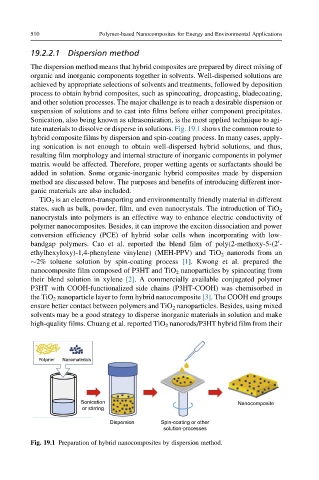Page 557 - Polymer-based Nanocomposites for Energy and Environmental Applications
P. 557
510 Polymer-based Nanocomposites for Energy and Environmental Applications
19.2.2.1 Dispersion method
The dispersion method means that hybrid composites are prepared by direct mixing of
organic and inorganic components together in solvents. Well-dispersed solutions are
achieved by appropriate selections of solvents and treatments, followed by deposition
process to obtain hybrid composites, such as spincoating, dropcasting, bladecoating,
and other solution processes. The major challenge is to reach a desirable dispersion or
suspension of solutions and to cast into films before either component precipitates.
Sonication, also being known as ultrasonication, is the most applied technique to agi-
tate materials to dissolve or disperse in solutions. Fig. 19.1 shows the common route to
hybrid composite films by dispersion and spin-coating process. In many cases, apply-
ing sonication is not enough to obtain well-dispersed hybrid solutions, and thus,
resulting film morphology and internal structure of inorganic components in polymer
matrix would be affected. Therefore, proper wetting agents or surfactants should be
added in solution. Some organic-inorganic hybrid composites made by dispersion
method are discussed below. The purposes and benefits of introducing different inor-
ganic materials are also included.
TiO 2 is an electron-transporting and environmentally friendly material in different
states, such as bulk, powder, film, and even nanocrystals. The introduction of TiO 2
nanocrystals into polymers is an effective way to enhance electric conductivity of
polymer nanocomposites. Besides, it can improve the exciton dissociation and power
conversion efficiency (PCE) of hybrid solar cells when incorporating with low-
bandgap polymers. Cao et al. reported the blend film of poly(2-methoxy-5-(2 -
0
ethylhexyloxy)-1,4-phenylene vinylene) (MEH-PPV) and TiO 2 nanorods from an
2% toluene solution by spin-coating process [1]. Kwong et al. prepared the
nanocomposite film composed of P3HT and TiO 2 nanoparticles by spincoating from
their blend solution in xylene [2]. A commercially available conjugated polymer
P3HT with COOH-functionalized side chains (P3HT-COOH) was chemisorbed in
the TiO 2 nanoparticle layer to form hybrid nanocomposite [3]. The COOH end groups
ensure better contact between polymers and TiO 2 nanoparticles. Besides, using mixed
solvents may be a good strategy to disperse inorganic materials in solution and make
high-quality films. Chuang et al. reported TiO 2 nanorods/P3HT hybrid film from their
Polymer Nanomaterials
Sonication Nanocomposite
or stirring
Dispersion Spin-coating or other
solution-processes
Fig. 19.1 Preparation of hybrid nanocomposites by dispersion method.

